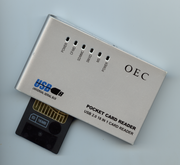Sections in ITALICS are copied directly from the web site at the link above them. ie. click on
the link to read the full article and find more information.
A USB Card Reader

http://en.wikipedia.org/wiki/Photograph
"Non-digital photographs are produced with a two-step chemical process. In the two-step process the light-sensitive film captures a negative image (colors and lights/darks are inverted). To produce a positive image, the negative is most commonly transferred ('printed') onto photographic paper. Printing the negative onto transparent film stock is used to manufacture motion picture films."
digital photography
"The advent of the microcomputer and digital photography has led to the rise of digital prints. These prints are created from stored graphic formats such as JPEG, TIFF, and RAW. The types of printers used include inkjet printers, dye-sublimation printer, laser printers, and thermal printers. Inkjet prints are sometimes given the coined name "Giclée"."
"Digital photography is a form of photography that utilizes digital technology to make digital images of subjects. Until the advent of digital technology, photography used photographic film to create images which could be made visible by photographic processing. Digital images can be displayed, printed, stored, manipulated, transmitted, and archived using digital and computer techniques, without chemical processing.
Digital photography is one of several forms of digital imaging. Digital images are also created by non-photographic equipment such as computer tomography scanners and radio telescopes. Digital images can also be made by scanning conventional photographic images."
The main difference between the digital and analog is that digital must have a certain number of
steps or gradations but an analog representation has an infinitely fine number of steps and as such
should be able to produce a finer gradation.
As an example in a digital vs analog photo containing the sun the digital print will usually just be
smooth white but the analog may show some detail.
http://en.wikipedia.org/wiki/Pixel
"In digital imaging, a pixel (picture element[1]) is the smallest piece of information in an image.
Pixels are normally arranged in a regular 2-dimensional grid, and are often represented using
dots, squares, or rectangles. Each pixel is a sample of an original image, where more samples
typically provide a more accurate representation of the original. The intensity of each pixel is
variable; in color systems, each pixel has typically three or four components such as
red, green, and blue, or cyan, magenta, yellow, and black."
"This example shows an image with a portion greatly enlarged, in which the individual
pixels are rendered as little squares and can easily be seen."
"A photograph of sub-pixel display elements on a laptop's LCD screen"
That is to say the red, green and blue bar work together to make one pixel
"A pixel does not need to be rendered as a small square. This image shows alternative
ways of reconstructing an image from a set of pixel values, using dots, lines, or smooth filtering."
Blogged with the Flock Browser
No comments:
Post a Comment